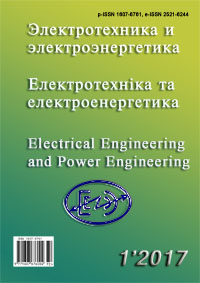MODEL OF A STEPPER MOTOR FOR STUDYING OF AUTOMATED POSITIONING SYSTEMS IN ECAD
DOI:
https://doi.org/10.15588/1607-6761-2017-1-5Keywords:
stepper motor, ACS, positioning systems, abstraction level, ECAD, behavioral elements, macromodelAbstract
Purpose. Development of an economical Stepping Motor’s (SM) macromodel for the study of positioning systems and other robotic mechatronic systems in computer-aided design (ECAD) programs, which does not generate algorithmic failures in comparison with the existing models of SM.Methodology. The modeling of the Stepping Motor was carried out on the basis of behavioral elements from the ECAD library, the model of the system was obtained in terms of the theory of automatic control. For effective simulation of automatic control systems in the acausal mathematical environment, models are given up to causality through dependent sources, controlled by voltage. The object of the study is simulation of ACS with SM as actuators in ECAD; the subject of the study is the models of SM.
Findings. Based on the analysis of the adequacy areas and the mathematical apparatus of the existing SM models, criteria for the synthesis of an economical model suitable for adequate macromodeling of ACS with SM in the ECAD environment have been identified. The compact model of SM was developed, which was investigated in the steady state under the load. During the approbation and verification by simulation of the positioning subsystem of the automated system for determining the surface potential, it is established that the model provides high speed and algorithmic reliability of the simulation and high accuracy analysis of dynamic characteristics. The macromodel is installed in the Micro Cap 11 library.
Originality. The new macromodel of SM that meets the criteria of adequacy, reliability and economy, synthesized on the basis of a new approach in modeling objects at the macro level, which combines the principles of constructing structures and links of automatic control systems in accordance with the theory of automatic control with the capabilities of behavioral modeling in the program of computer-aided design in Electronics (ECAD). Transfer functions for such models are constructed as a function of time, without transition to a complex plane, which allows expanding the range of their adequacy, in comparison with the classical models. Such macromodels allow us to study dynamic modes in automated positioning systems.
Practical value. SM macromodel expands the mathematical support of ECAD reduces the likelihood of the appearance of algorithmic failures and accelerates the modeling of ACS in ECAD. Approach, which used during its synthesis, allows us to build similar models for other software (CAS, CAE).
References
Vasylenko, O. V. (2015). Analiz prohram dlya modelyuvannya mekhatronnykh system, Radioelektronika, informatika, upravlenie , 3, 80–88. DOI: 10.15588/1607-3274-2015-3-10
Vasylenko O. V. (2015). Modeling of multidomain automatic control Systems in ECAD, Visnyk Akademiyi mytnoyi sluzhby Ukrayiny. Seriya: Tekhnichni nauky, 2015, 1, 13-19.
Kovalenko, M. A., Matsiuk, D. S. (2015). Avtonomnyi eksperymentalnyi stend dlia vyprobuvannia unipoliarnoho krokovoho dvyhuna na bazi mikrokontrolera, Elektrotekhnika ta elektroenerhetyka, 2, 15–20. DOI: http://dx.doi.org/10.15588/1607-6761-2015-2-2
Simulink. Simulation and Model-Based Design. [Electronic resource]. – Access mode: https://www.mathworks.com/products/simulink.html?s_tid=hp_products_simulink
Zakariana, Vaagn L, Kaiser, Mark J. Kaiser. Computeraided design of synchronous generators with comb rotors, Applied Mathematical Modelling , 1999, Vol.23, pp. 1–18. DOI: 10.1016/S0307-904X(98)10046-X. [Electronic resource]. – Access mode: http://www.sciencedirect.com/science/article/pii/S0307904X9810046X
Condit Reston. Stepping Motors Fundamentals. University of Iowa, 2004 Microchip Technology Inc. [Electronic resource]. – Access mode: https://homepage.divms.uiowa.edu /~jones/step/an907a.pdf
MathWorks. Simscape Electronics. Model and simulate electronic and mechatronic systems. [Electronic resource]. – Access mode: https://www.mathworks.com/products/ simelectronics.html
Mathworks Model Stepper Motor. Mathworks Documentation. [Electronic resource]. – Access mode: https://www.mathworks.com/help/ physmod/elec/ref/steppermotor.html
Morar Alexandru. Stepper Motor Model for Dynamic Simulation. [Electronic resource]. – Access mode: http://www.old.ie.utcluj.ro/Contents_Acta_ET /2003/Number%202/ Paper08_Morar.pdf
Picatoste Ruilope, Ricardo. Modelling and Control of Stepper Motors for High Accuracy Positioning Systems Used in Radioactive Environments. Departamento de automмatica, ingenierмэa electrмonica einformмatica industrial Escuela Tмecnica Superior de Ingenieros Industriales Centro de Electronica Industrial, Madrid, 2014, 195 p. [Electronic resource]. – Access mode: https://cds.cern.ch/record/2226506/files/tesis-Ricardo-Picatoste.pdf
Kitaev, A. V. Agbomassu, V. L., Gluhova, V. I. (2013). Shemyi zamescheniya elektricheskih mashin, Elektrotekhnika ta elektroenerhetyka, 2, 14–26. DOI: http://dx.doi.org/10.15588/1607-6761-2013-2-2
Micro-Cap 11 Electronic Circuit Analysis Program. User’s Guide. © Spectrum Software. 1982-2014, 224 p. [Electronic resource]. – Access mode: http://www.spectrum-soft.com/down/ug11.pdf
Vasylenko, O. V. (2016) Povyishenie kachestva modelirovaniya dinamicheskih sistem vyiborom optimalnyih algoritmov simulyatsii, Radioelektronika, informatika, upravlenie, 4, 11–18. DOI: 10.15588/1607-3274-2016-4-2
Vasylenko, O. V., Zhavzharov, Ie. L. (2017). Аutomated scanning system of the surface potential, Scientific Bulletin of National Mining University, 1 (157), 69–74.
Patent for Utility Model. 104591 Ukraine, МPК G01R 29/12 (2006.01), G01N 27/87 (2006.01). The device for automatic measurement of potential difference by contactless method / Zhavzharov I. L., Nagorna N. M., Smyrnova N. A.; Owner of Zaporizhzhya National Technical University – no. u201507171; Claimed 17.07.2015; Published 10.02.2016, Bulletin no. 3, 2016. (in Ukrainian).
Spice Solutions and Technologies. [Electronic resource]. – Access mode: http://www.pspice.com/
Downloads
Published
How to Cite
Issue
Section
License
Copyright (c) 2017 O. V. Vasylenko, I. L. Zhavzharov

This work is licensed under a Creative Commons Attribution 4.0 International License.
Creative Commons Licensing Notifications in the Copyright Notices
Authors who publish with this journal agree to the following terms:
Authors retain copyright and grant the journal right of first publication with the work simultaneously licensed under aCreative Commons Attribution License that allows others to share the work with an acknowledgement of the work's authorship and initial publication in this journal.
Authors are able to enter into separate, additional contractual arrangements for the non-exclusive distribution of the journal's published version of the work (e.g., post it to an institutional repository or publish it in a book), with an acknowledgement of its initial publication in this journal.
Authors are permitted and encouraged to post their work online (e.g., in institutional repositories or on their website) prior to and during the submission process, as it can lead to productive exchanges, as well as earlier and greater citation of published work.

